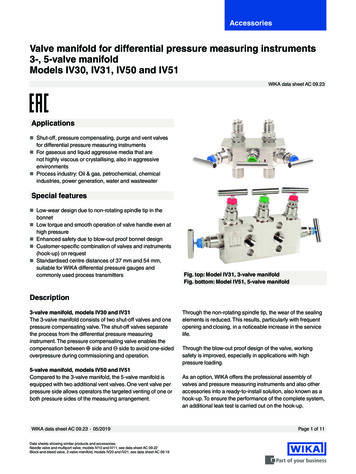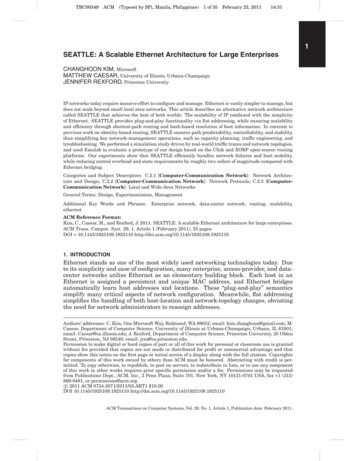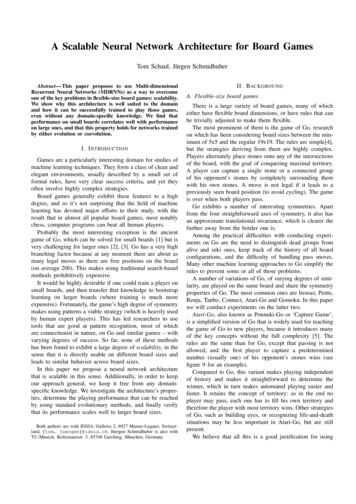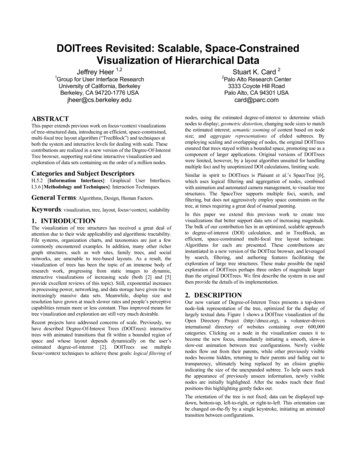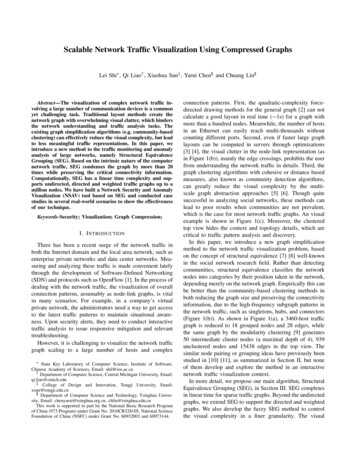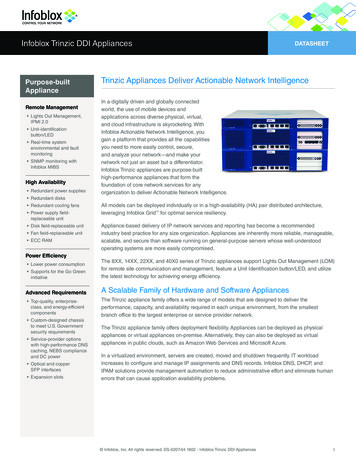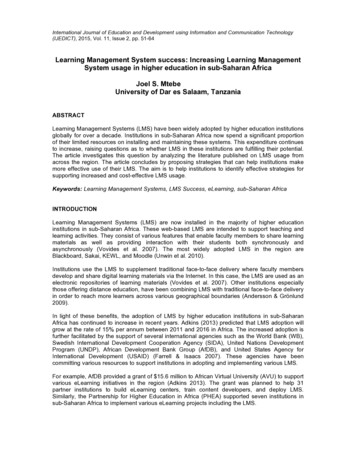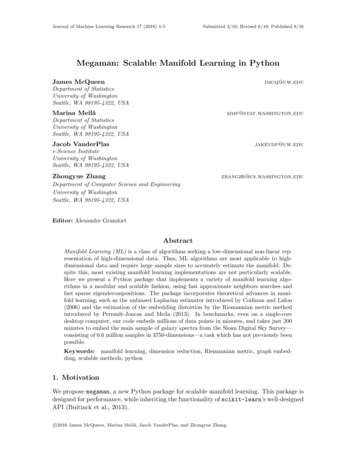
Transcription
Journal of Machine Learning Research 17 (2016) 1-5Submitted 3/16; Revised 6/16; Published 8/16Megaman: Scalable Manifold Learning in PythonJames McQueenjmcq@uw.eduDepartment of StatisticsUniversity of WashingtonSeattle, WA 98195-4322, USAMarina Meilămmp@stat.washington.eduDepartment of StatisticsUniversity of WashingtonSeattle, WA 98195-4322, USAJacob VanderPlasjakevdp@uw.edue-Science InstituteUniversity of WashingtonSeattle, WA 98195-4322, USAZhongyue Zhangzhangz6@cs.washington.eduDepartment of Computer Science and EngineeringUniversity of WashingtonSeattle, WA 98195-4322, USAEditor: Alexandre GramfortAbstractManifold Learning (ML) is a class of algorithms seeking a low-dimensional non-linear representation of high-dimensional data. Thus, ML algorithms are most applicable to highdimensional data and require large sample sizes to accurately estimate the manifold. Despite this, most existing manifold learning implementations are not particularly scalable.Here we present a Python package that implements a variety of manifold learning algorithms in a modular and scalable fashion, using fast approximate neighbors searches andfast sparse eigendecompositions. The package incorporates theoretical advances in manifold learning, such as the unbiased Laplacian estimator introduced by Coifman and Lafon(2006) and the estimation of the embedding distortion by the Riemannian metric methodintroduced by Perrault-Joncas and Meila (2013). In benchmarks, even on a single-coredesktop computer, our code embeds millions of data points in minutes, and takes just 200minutes to embed the main sample of galaxy spectra from the Sloan Digital Sky Survey—consisting of 0.6 million samples in 3750-dimensions—a task which has not previously beenpossible.Keywords: manifold learning, dimension reduction, Riemannian metric, graph embedding, scalable methods, python1. MotivationWe propose megaman, a new Python package for scalable manifold learning. This package isdesigned for performance, while inheriting the functionality of scikit-learn’s well-designedAPI (Buitinck et al., 2013).c 2016 James McQueen, Marina Meilă, Jacob VanderPlas, and Zhongyue Zhang.
McQueen, Meilă, VanderPlas, and Zhang2. Downloading and installationmegaman is publicly available at: https://github.com/mmp2/megaman. megaman’s requireddependencies are numpy, scipy, and scikit-learn, but for optimal performance FLANN,cython, pyamg and the C compiler gcc are also required. For unit tests and integrationmegaman depends on nose. The most recent megaman release can be installed along with itsdependencies using the cross-platform conda 1 package manager: conda install megaman -- channel conda - forgeAlternatively, megaman can be installed from source by downloading the source repositoryand running: python setup . py installWith nosetests installed, unit tests can be run with: make test3. Logical structure and classes overviewembeddings The manifold learning algorithms are implemented in their own classes inheriting from a base class. Included are SpectralEmbedding, which implements LaplacianEigenmaps (Belkin and Niyogi, 2002) and Diffusion Maps (Nadler et al., 2006), LTSA (Zhangand Zha, 2004), LocallyLinearEmbedding (Roweis and Saul, 2000), and Isomap (Bernsteinet al., 2000). Geometric operations common to many or all embedding algorithms (suchas computing distances, Laplacians) are implemented by the Geometry class. A Geometryobject is passed or created inside every embedding class. In particular, RiemannianMetricproduces the estimated Riemannian metric via the method of Perrault-Joncas and Meila(2013). eigendecomposition (module) provides a unified (function) interface to the different eigendecomposition methods provided in scipy.For background of manifold learning, as well as megaman’s design philosophy, please seeMcQueen et al. (2016).4. Quick startfrom megaman . geometry import Geometryfrom megaman . embedding import Sp ectral Embedd ingfrom sklearn . datasets import make swiss rollX make swiss roll ( 10000 ) # generate input dataradius 1.1 # kernel bandwidth and for graph construction# a Geometry object encapsulates generic geometric operationsgeom Geometry (adjacency kwds { ’ radius ’:3* radius } , # neighborhood radiusadjacency method ’ cyflann ’ , # fast approximate neighbors1. Conda can be downloaded at http://conda.pydata.org/miniconda.html.2
Megaman: Scalable Manifold Learning in Pythonaffinity method ’ gaussian ’ ,# Gaussian kernelaffinity kwds { ’ radius ’: radius } ,# kernel bandwidthlaplacian method ’ geometric ’)# unbiased LaplacianSE Spe ctralE mbeddi ng ( # embedding algorithm & paramsn components 2 ,# embed into 2 dimensionseigen solver ’ amg ’ ,geom geom )# pass the geometric informationY SE . fit transform ( X )# perform embeddingThe last two instructions are identical to their analogous instructions in scikit-learn. Fulldocumentation is available from the megaman website at: http://mmp2.github.io/megaman/5. BenchmarksThe one other popular comparable implementation of manifold learning algorithms is thescikit-learn package. To make the comparison as fair as possible, we choose theSpectralEmbedding method for the comparison, with radius-based neighborhoods and theLocally-Optimized Block-Preconditioned Conjugate Gradient (lobpcg) eigensolver. Note, too,that with the default settings, scikit-learn would perform slower than in our experiments.We display total embedding time (including time to compute the graph G, the Laplacian matrix and the embedding 2 ) for megaman versus scikit-learn, as the number ofsamples N varies or the data dimension D varies (Figure 1). All benchmark computationswere performed on a single desktop computer running Linux with 24.68GB RAM and aQuad-Core 3.07GHz Intel Xeon CPU. We use a relatively weak machine to demonstratethat our package can be reasonably used without high performance hardware. The experiments show that megaman scales considerably better than scikit-learn, even in the mostfavorable conditions for the latter; the memory footprint of megaman is smaller, even whenscikit-learn uses sparse matrices internally. The advantages grow as the data size grows,whether it is w.r.t D or to N .We also report run times on two real world data sets. The first is the word2vec data set3 which contains feature vectors in 300 dimensions for about 3 million words and phrases,extracted from Google News. The vector representation was obtained via a multilayer neural network by Mikolov et al. (2013). The second data set contains galaxy spectra from theSloan Digital Sky Survey 4 (Abazajian et al., 2009), preprocessed as described in Telfordet al. (2016).Run time [min]DatasetSize N Dimensions D Distances Embedding R. metric TotalGalaxies0.7M3750190.58.90.1 199.5Word2Vec3M300107.944.80.6 153.32. For megaman we also compute the Riemannian metric estimate at each point; this time is negligiblecompared to the total time to obtain the embedding.3. The word2vec data used were from GoogleNews-vectors-negative300.bin.gz which can be downloadedfrom https://code.google.com/archive/p/word2vec/.4. The Sloan Digital Sky Survey data can be downloaded from www.sdss.org.3
McQueen, Meilă, VanderPlas, and ZhangFigure 1: Run time vs. data set size N for fixed D 100 (left) and Run time vs. data setdimension D for fixed N 50, 000 (right). The data is from a Swiss Roll (in 3 dimensions)with additional noise dimensions, embedded into s 2 dimensions by the SpectralEmbeddingalgorithm. By D 10, 000 and N 1, 000, 000 scikit-learn was unable to compute anembedding due to insufficient memory. All megaman run times (including time between distanceand embedding) are faster than scikit-learn.6. Conclusionmegaman puts in the hands of scientists and methodologists alike tools that enable them toapply state of the art manifold learning methods to data sets of realistic size. The packageis extensible, modular, with an API familiar to scikit-learn users. Future developmentwill be mainly in the direction of further scalability (Nystrom extension, parallelization)and expanding the data analytical tools (distance calculations, estimation of dimension,estimation of neighborhood radius, directed graph embedding).We hope that by providing this package, non-linear dimension reduction will be benefitthose who most need it: the practitioners exploring large scientific data sets.AcknowledgmentsWe would like to acknowledge support for this project from the National Science Foundation(NSF grant IIS-9988642), the Multidisciplinary Research Program of the Department of Defense (MURI N00014-00-1-0637), the Department of Defense (62-7760 “DOD UnclassifiedMath”), the Moore/Sloan Data Science Environment grant, and funding from the Washington Research Foundation. This project grew from the Data Science Incubator program5 at the University of Washington eScience Institute.5. For more information on Data Science Incubator program see http://data.uw.edu/incubator/.4
Megaman: Scalable Manifold Learning in PythonReferencesK. N. Abazajian, J. K. Adelman-McCarthy, M. A. Agüeros, S. S. Allam, C. Allende Prieto,D. An, K. S. J. Anderson, S. F. Anderson, J. Annis, N. A. Bahcall, and et al. The SeventhData Release of the Sloan Digital Sky Survey. Astrophysical Journal Supplement Series,182:543-558, June 2009. doi: 10.1088/0067-0049/182/2/543.M. Belkin and P. Niyogi. Laplacian eigenmaps and spectral techniques for embedding andclustering. In T. G. Dietterich, S. Becker, and Z. Ghahramani, editors, Advances inNeural Information Processing Systems 14, Cambridge, MA, 2002. MIT Press.Mira Bernstein,Vin de Silva,John C. Langford,and Josh Tennenbaum.Graph approximations to geodesics on embedded pdf, December 2000.Lars Buitinck, Gilles Louppe, Mathieu Blondel, Fabian Pedregosa, Andreas Mueller, OlivierGrisel, Vlad Niculae, Peter Prettenhofer, Alexandre Gramfort, Jaques Grobler, et al. APIdesign for machine learning software: experiences from the scikit-learn project. arXivpreprint arXiv:1309.0238, 2013.R. R. Coifman and S. Lafon. Diffusion maps. Applied and Computational Harmonic Analysis, 30(1):5–30, 2006.James McQueen, Marina Meila, Jacob VanderPlas, and Zhongyue Zhang. megaman: Manifold learning with millions of points. arXiv e-prints: 1603.02763, March 2016.Tomas Mikolov, Ilya Sutskever, Kai Chen, Greg Corrado, and Jeffrey Dean. Distributedrepresentations of words and phrases and their compositionality. In Advances in NeuralInformation Processing Systems 26, 2013.Boaz Nadler, Stephane Lafon, Ronald Coifman, and Ioannis Kevrekidis. Diffusionmaps, spectral clustering and eigenfunctions of Fokker-Planck operators. In Y. Weiss,B. Schölkopf, and J. Platt, editors, Advances in Neural Information Processing Systems18, pages 955–962, Cambridge, MA, 2006. MIT Press.D. Perrault-Joncas and M. Meila. Non-linear dimensionality reduction: Riemannian metricestimation and the problem of geometric discovery. arXiv e-prints:1305.7255, May 2013.Sam Roweis and Lawrence Saul. Nonlinear dimensionality reduction by locally linear embedding. Science, 290(5500):2323–2326, December 2000.O. Grace Telford, Jacob Vanderplas, James McQueen, and Marina Meila. Metric embeddingof Sloan galaxy spectra. (in preparation), 2016.Zhenyue Zhang and Hongyuan Zha. Principal manifolds and nonlinear dimensionality reduction via tangent space alignment. SIAM J. Scientific Computing, 26(1):313–338, 2004.5
Journal of Machine Learning Research 17 (2016) 1-5 Submitted 3/16; Revised 6/16; Published 8/16 Megaman: Scalable Manifold Learning in Python James McQueen jmcq@uw.edu Department of Statistics University of Washington Seattle, WA 98195-4322, USA Marina Meil a mmp@stat.washington.edu Departme
